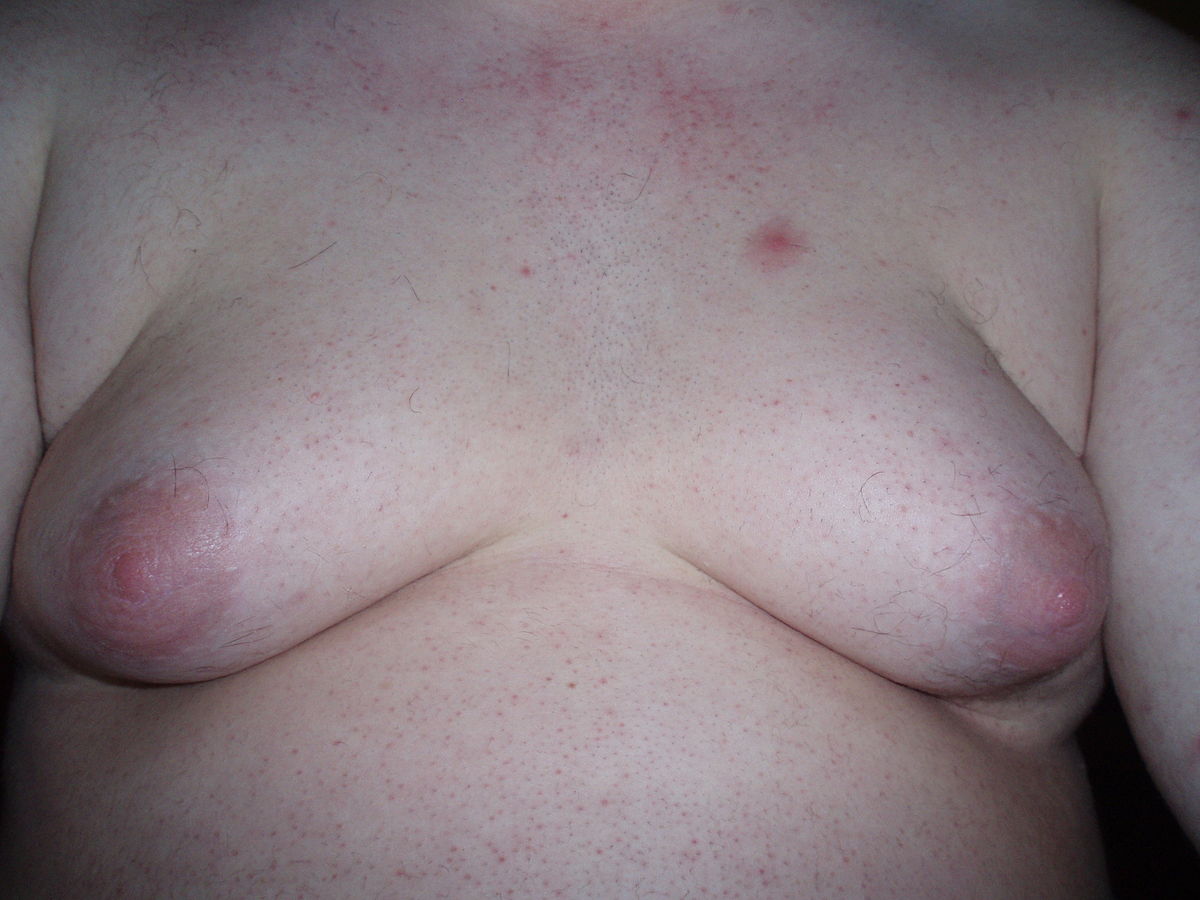Gynecomastia pathophysiology: Difference between revisions
Jump to navigation
Jump to search
| Line 3: | Line 3: | ||
{{CMG}}; {{AE}}Husnain Shaukat | {{CMG}}; {{AE}}Husnain Shaukat | ||
==Overview== | ==Overview== | ||
The main pathophysiology behind gynecomastia is the result of increased estrogen to androgen ratio which can occur through multiple mechanisms that can be physiological | The main pathophysiology behind gynecomastia is the result of increased estrogen to androgen ratio which can occur through multiple mechanisms that can be physiological, pathological or use of certain medications. | ||
==Pathophysiology== | ==Pathophysiology== | ||
Revision as of 14:28, 10 August 2017
|
Gynecomastia Microchapters |
|
Diagnosis |
|---|
|
Treatment |
|
Case Studies |
|
Gynecomastia pathophysiology On the Web |
|
American Roentgen Ray Society Images of Gynecomastia pathophysiology |
|
Risk calculators and risk factors for Gynecomastia pathophysiology |
Editor-In-Chief: C. Michael Gibson, M.S., M.D. [1]; Associate Editor(s)-in-Chief: Husnain Shaukat
Overview
The main pathophysiology behind gynecomastia is the result of increased estrogen to androgen ratio which can occur through multiple mechanisms that can be physiological, pathological or use of certain medications.
Pathophysiology
Hormones involved in breast development
- Estrogen and Progesterone act in a coordinated manner to support breast development. Estrogen helps duct growth and progesterone promotes alveolar development.[1] [2]
- Growth hormone which acts through IGF-1 acts as a mediator in the presence of estrogen and progesterone for ductal breast duct development.[3] In a population based study of adolescent school boys, IGH-1 levels were higher in boys with pubertal gynecomastia suggesting the involvement of GH and IGF-1 in the pathogenesis of gynecomastia.[4]
- Prolactin in the presence of estrogen and progesterone also supports breast development. It also plays an indirect role as it causes central hypogonadism which alters the androgen/estrogen balance.[5] [6]
- Aromatase catalyzes the conversion of androgens to estrogen and so initiate the cascade to breast development. So, gynecomastia can result from overexpression of aromatase.[7] [8]
| Breast Tissue | |||||||||||||||||||||||||||||||||||||||||||||||||||||||||||||||||||
| Stimulatory Action | Inhibitory Action | ||||||||||||||||||||||||||||||||||||||||||||||||||||||||||||||||||
| Estrogen | Androgens | ||||||||||||||||||||||||||||||||||||||||||||||||||||||||||||||||||
| GH & IGF-1 | |||||||||||||||||||||||||||||||||||||||||||||||||||||||||||||||||||
Pathogenesis
- It is thought that Gynecomastia can result from any condition, drugs or disease state that causes an increase in circulating estrogen, decrease in androgen or the sensitivity of the breast tissue to the circulating estrogen.[5]
- The imbalance of estrogen/androgen can be due to increased levels of free estrogen secreted by the adrenals or testes, decreased estrogen breakdown, increased availability of estrogen precursors, exposure to estrogen like products or use of drugs that displaces more estrogen than androgen from sex hormone-binding globulin (SHBG).
- On the other hand, the imbalance can result from altered androgen metabolism, decreased androgen production, increased androgen binding (relative to estrogen) by SHBG, or androgen receptor defects.[9] [10] [5]
Genetics
- Genes involved in the pathogenesis of aromatase overexpression form of gynecomastia is encoded by a chromosome 15q21.2.[8]
Associated Conditions
Gross Pathology
- On gross pathology, excessive breast tissue and subaerolar mass are characteristic findings of gynecomastia.

Microscopic Pathology
- On microscopic histopathological analysis, ductal hyperplasia, increase in periductal connective tissue, are characteristic findings of gynecomastia.[11]

References
- ↑ Bocchinfuso WP, Korach KS (1997). "Mammary gland development and tumorigenesis in estrogen receptor knockout mice". J Mammary Gland Biol Neoplasia. 2 (4): 323–34. PMID 10935020.
- ↑ Lubahn DB, Moyer JS, Golding TS, Couse JF, Korach KS, Smithies O (1993). "Alteration of reproductive function but not prenatal sexual development after insertional disruption of the mouse estrogen receptor gene". Proc. Natl. Acad. Sci. U.S.A. 90 (23): 11162–6. PMC 47942. PMID 8248223.
- ↑ Kleinberg DL, Feldman M, Ruan W (2000). "IGF-I: an essential factor in terminal end bud formation and ductal morphogenesis". J Mammary Gland Biol Neoplasia. 5 (1): 7–17. PMID 10791764.
- ↑ Mieritz MG, Sorensen K, Aksglaede L, Mouritsen A, Hagen CP, Hilsted L, Andersson AM, Juul A (2014). "Elevated serum IGF-I, but unaltered sex steroid levels, in healthy boys with pubertal gynaecomastia". Clin. Endocrinol. (Oxf). 80 (5): 691–8. doi:10.1111/cen.12323. PMID 24033660.
- ↑ 5.0 5.1 5.2 De Groot LJ, Chrousos G, Dungan K, Feingold KR, Grossman A, Hershman JM, Koch C, Korbonits M, McLachlan R, New M, Purnell J, Rebar R, Singer F, Vinik A, Swerdloff RS, Ng J. PMID 25905330. Vancouver style error: initials (help); Missing or empty
|title=(help) - ↑ Barros AC, Sampaio Mde C (2012). "Gynecomastia: physiopathology, evaluation and treatment". Sao Paulo Med J. 130 (3): 187–97. PMID 22790552.
- ↑ Li X, Wärri A, Mäkelä S, Ahonen T, Streng T, Santti R; et al. (2002). "Mammary gland development in transgenic male mice expressing human P450 aromatase". Endocrinology. 143 (10): 4074–83. doi:10.1210/en.2002-220181. PMID 12239119.
- ↑ 8.0 8.1 Shozu M, Sebastian S, Takayama K, Hsu WT, Schultz RA, Neely K; et al. (2003). "Estrogen excess associated with novel gain-of-function mutations affecting the aromatase gene". N Engl J Med. 348 (19): 1855–65. doi:10.1056/NEJMoa021559. PMID 12736278.
- ↑ Johnson RE, Murad MH (2009). "Gynecomastia: pathophysiology, evaluation, and management". Mayo Clin Proc. 84 (11): 1010–5. doi:10.1016/S0025-6196(11)60671-X. PMC 2770912. PMID 19880691.
- ↑ Mathur R, Braunstein GD (1997). "Gynecomastia: pathomechanisms and treatment strategies". Horm Res. 48 (3): 95–102. PMID 11546925.
- ↑ Nicolis GL, Modlinger RS, Gabrilove JL (1971). "A study of the histopathology of human gynecomastia". J Clin Endocrinol Metab. 32 (2): 173–8. doi:10.1210/jcem-32-2-173. PMID 5539033.